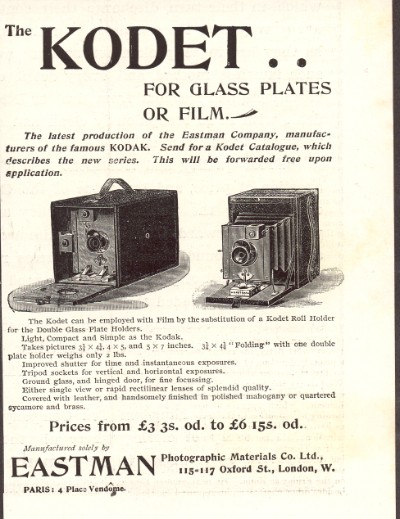 | 
| 
 
No. 4 Kodet (1894)The two Kodet box cameras are both extremely rare. This is the larger one. It took 4 x 5 inch (10 x 12,5 cm) pictures on glass plates or a darkroom loaded spool of film for 48 exposures. In the back there is room for 3 double plate holders. All Kodets (box as well as folding cameras) were primarily plate cameras, but all of them could accomodate roll film holders. Why is that? Photography on rolls of film was very new in the early 1890's. During 1892 and 1893 the Eastman Kodak Co. experienced substantial difficulties with the quality of the films they produced. During part of 1893 production even stopped. Amateur photographers lost confidence in the still very young system of film photography and this was quite a blow for the company. To keep the customers Eastman introduced a number of competitive plate cameras during 1894: the Kodets. So if a potential buyer didn't trust films, he could very well buy a Kodet with plate holders and later on switch to a film holder without difficulty. One of these Kodet cameras is the No. 4 Kodet, sometimes also called No. 4 Regular Kodet. Because plate cameras were easy to produce, their price was not high (in many cases). To compete with the cheap cameras from other manufacturers, Eastman also had to offer his Kodets for a low price. Economy in production resulted in cameras of a poorer grade. The construction is not as sturdy as with the other Kodaks, the leather is of poorer quality and the shutter mechanism is simpler. With the Kodet cameras Eastman reached a public that could not afford a more expensive instrument (or would not care to spend more money). The No. 4 Kodet cost $ 15 with a simple Achromatic lens or $ 20 with a better Rapid Rectilinear. 
1895 ad. | The No. 4 Kodet was an easy to use camera, intended for the shapshooter who did not want to bother about special knowledge: - The shutter can be set on Time and Instantaneous, and the speed can be adjusted a bit by a lever on front of the lensboard. In the video this lever can be seen below the lens.
- There is a wheel with stops.
- Focusing could be done with the help of a distance scale.
- If the photographer wanted to, he could focus on the ground glass that is housed in the back of the camera box.
- The photographer could use the little reflecting finders to aim the camera at the scene. He didn't have to use the ground glass for focusing and composing the image.
The No. 4 was made from 1894 until 1897, during which time 1413 were made. |
|
 |
| |  |
|